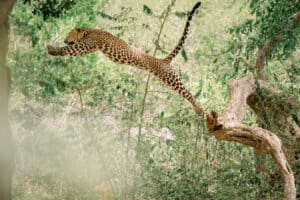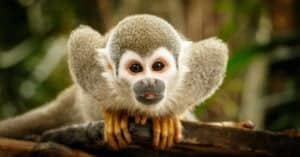As most monkeys are arboreal and adapted to move swiftly through the trees, most of them are small in size, at least when compared to apes such as chimps and gorillas or ground-dwelling monkeys such as baboons. Here is a list of the world’s smallest monkeys, from the largest of the smallest to the tiniest.
The length describes the distance from the nose to the root of the tail. In some of these monkeys, their tail is considerably longer than their body and often prehensile.

#10 Talapoin Monkey

Talapoins are the smallest old World monkeys. They can live in groups of up to one hundred individuals.
©Jossfoto/Shutterstock.com
The talapoin monkey is one of the smallest monkeys in Africa and is found in the central-western part of the continent. With a weight between 1.76 to 4.19 pounds, this animal has a body length of between 10 and 16 inches and a tail that is just as long or longer.
It lives among the trees of the rain forests, mangrove swamps, and even plantations, most often near a body of water. It is an omnivore and will eat fruit, leaves, seeds, eggs, insects, and aquatic plants. It’s also been known to raid plantations.
The talapoin is a little unusual because the normal color of its fur is light green. Its chest and belly fur are pale, and it has fan-shaped whiskers and prominent ears. it lives in family groups that may join up with others. The monkey breeds once a year.
#9 Dusky Titi

Dusky titi monkeys are a monogamous primate species that mostly eat fruit.
©David / flickr – License
This monkey is only found in central Brazil around the Amazon river basin and near the source of the Orinoco River. Its weight is about 28.33 ounces on average, and its head and body length range from 10 to 16 inches. Dusky titis are monogamous and a basic group is a male, a female, and their children. The male usually carries the babies unless they are nursing.
Dusky titis have been seen to sit with their tails twined, whether they’re asleep or awake. Like most monkeys, titis are active in the day and enjoy a siesta around noon. They eat mostly fruit, especially figs, but will also take bird’s eggs, leaves, and insects. Titis are exceptionally vocal, and their vocalizations are unusually complex for monkeys.
#8 Squirrel Monkey
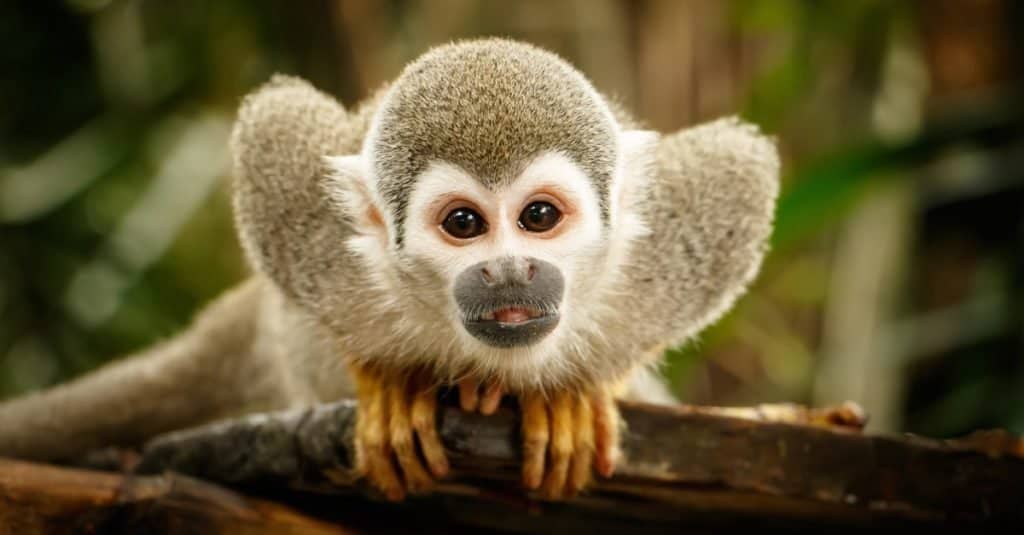
Squirrel
monkeys are the most abundant primate of riverside forests in The Guianas and the Amazon River basin.
©Ludmila Ruzickova/Shutterstock.com
The squirrel monkey lives in the canopies of the Central and South American forests. There are five species of squirrel monkeys and two main groups, and they range from about 10 o 14 inches long with a tail that’s about the same length or longer. Males weigh a bit more than females. The weight of a male squirrel monkey ranges from 26 to 39 ounces, while that of a female range from 18 to 26 ounces.
They have dense fur that’s black around the shoulders and orange-yellow at the back and rump. There are white patches above the eyes that make the monkey look a bit eldritch. They live in groups that can contain hundreds of members and are omnivores. Squirrel monkeys live around 15 years in the wild.
#7 Night Monkey

The night monkey is nocturnal and its large eyes allow for better night vision.
©Salparadis/Shutterstock.com
The night monkey is different from most other monkeys in that it is nocturnal. It’s found in savannas and wet and dry forests as high as 10,000 feet above sea level from Panama down to Argentina. An omnivore, it eats fruit, leaves, spiders, bird’s eggs, and once in a while birds and smaller mammals. As a nocturnal animal, it has large eyes evolved for good night vision.
The night monkey is 9.5 to 18 inches long, depending on the species. The average weight is between 1 pound and around 2.8 pounds. The night monkey is covered with thick gray or reddish-brown fur, with paler underparts. Its head resembles that of a squirrel monkey’s, with white patches above the eyes.
The female has one or maybe two babies a year, usually between September and March.
#6 Cotton-Top Tamarin
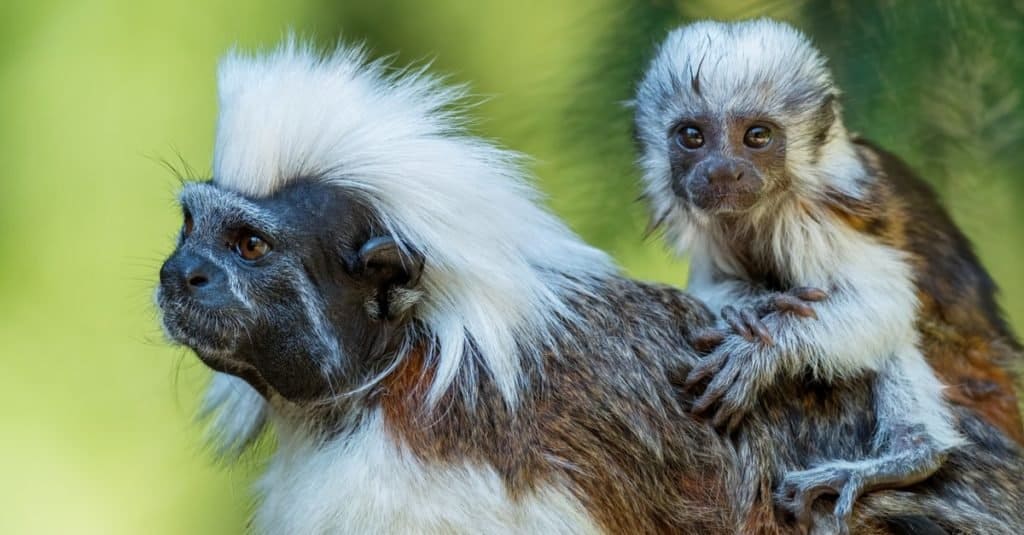
The cotton-top tamarin is critically endangered and there are only about 6,000 individuals left in the wild.
©David Havel/Shutterstock.com
At between 8.2 and 10.2 inches long and often less than a pound in weight, the cotton-top tamarin is one of the smallest of the New World monkeys. It’s found in the forests of Colombia, and since those forests are being rapidly destroyed, this little monkey is critically endangered. There are only about 6,000 of them alive.
The monkey gets its name from the white hair that explodes from the top of its head and continues down the back of its neck and over its shoulders. The monkey has a sagittal crest, much like a gorilla, and depending on the species, the tamarin can be mottled-faced, bare-faced, or hairy-faced. The color of its fur ranges from brown to cream-yellow to reddish-orange, and its density depends on where on the body it is found.
The tamarin also appears to have tusks in its lower jaw.
Another unusual thing about this monkey is that only the dominant female breeds, and all the other monkeys, especially males, take great care of her young.
#5 Graells’s Tamarin

Graells’s tamarins differ from other black-mantled tamarins in having a dull olive-brown lower back.
©David Havel/Shutterstock.com
Found in the tropical rainforests of the Amazon region of Ecuador, Peru, and Colombia, this tamarin ranges from 7.8 to 12 inches long without its equally long tail and has an average weight between 7.9 and 32 ounces. Males tend to be smaller than females. Its fur is long and silky and fairly uniformly colored in black or dark brown. These tamarins have claws on all of their fingers except their opposable thumb, which has a nail.
It differs from other black-mantled tamarins in having a dull olive-brown (no reddish-orange) lower back, rump, and thighs. However, the molecular genetic analysis does not support treating Graell’s tamarin as a separate species from the black-mantled tamarin.
Graells’s tamarins are monogamous and, as with the cotton-top tamarin, only the dominant pair is allowed to reproduce. The dominant female gives birth twice a year, at night, and she always has twins after a 130-170 day pregnancy.
#4 Common Marmoset
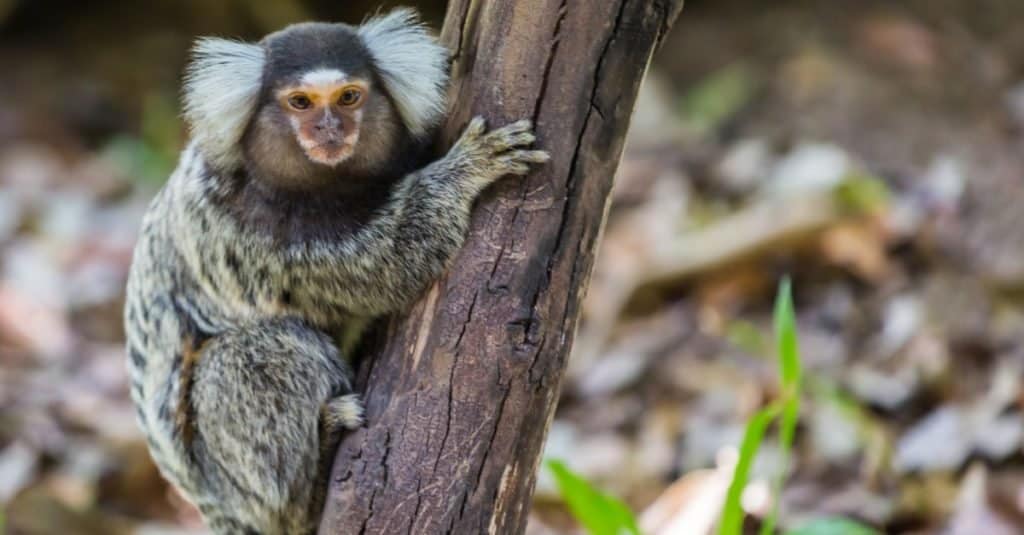
The common marmoset has spectacular white ear tufts and a banded tail.
©konmesa/Shutterstock.com
The common marmoset was the first New World monkey to have its entire genome sequenced. Besides that, it’s a small monkey whose males average around 7.4 inches in length with the females around 7.28 inches in length. Males are also heavier with a weight of around 9 ounces compared to the females’ 8.3 ounces.
The common marmoset has thick, colorful fur with spectacular white ear tufts and a banded tail. Like the tamarins, they have claws or nails that resemble claws on their fingers and a proper nail on their thumb. They are acrobatic where they live in the forests of southeastern Brazil. They have even been seen in cities.
This little monkey differs from others in that it eats plant secretions as well as insects, fruit, mushrooms, flowers, seeds, and smaller animals. It gets at the gums, saps, resins, and latex by chewing a hole in the tree then lapping the secretions up. This odd arrangement allows the monkey to have a food source when fruit and flowers are not in season.
A dominant female common marmoset breeds fairly regularly if the conditions are right. Because marmosets often have twins, they need the help of other family members to raise them.
#3 Silvery Marmoset
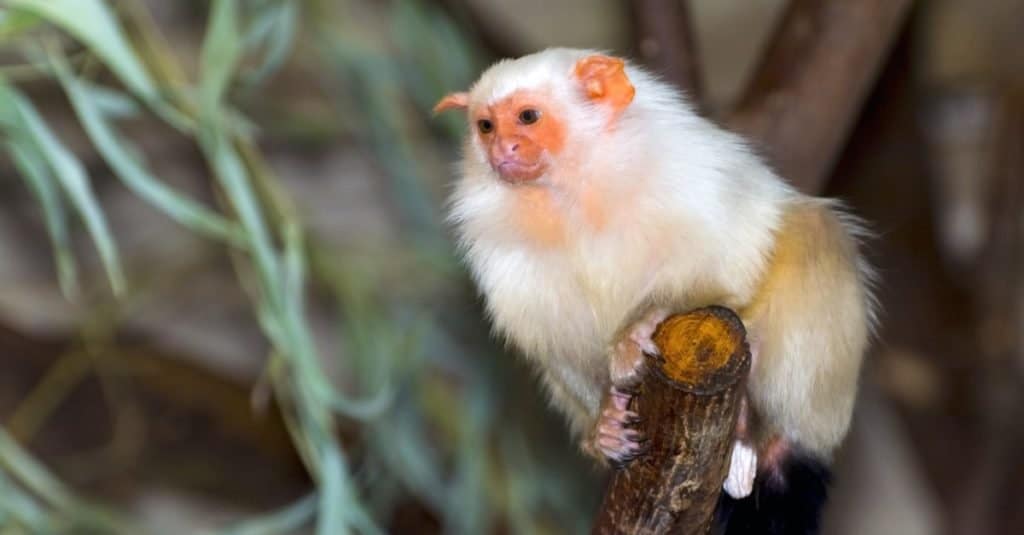
Silvery Marmosets differ from other marmosets in that their jaws come to a point.
©belizar/Shutterstock.com
Also found in the southeastern part of Brazil, this monkey is squirrel-sized, with a head and body length of between 7.1 to 11 inches and an average weight of about 48 ounces or 3 pounds. Though they can have silver-white fur, there are silvery marmosets whose fur is dark brown. Their ears and faces are naked, and the ears stand out. They are found in rainforests and plantations and live in small groups. They scream or grimace at intruders.
The silvery marmoset differs from other marmosets in that their jaws come to a point, rather like an opossum’s. This feature is because, like the common marmoset, it eats tree sap and needs to gnaw a hole in the tree to get at it. It also takes eggs, fruit, and insects. The monkey’s small size lets it catch insects with ease. Like other marmosets, the entire family helps raise the young.
#2 Roosmalen’s Dwarf Marmoset
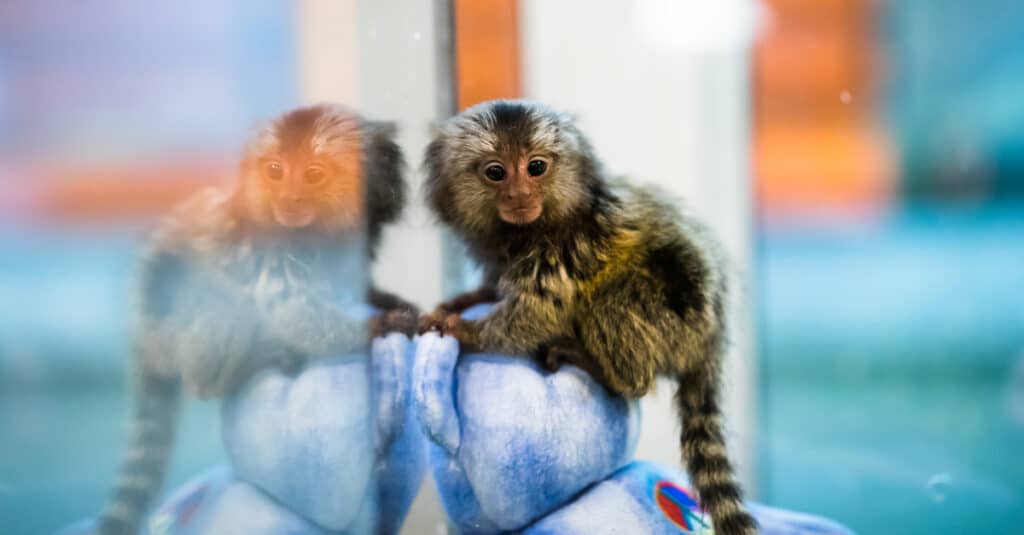
Unlike other marmosets, the Roosmalen’s Dwarf Marmoset is a member of the genus
Mico.
©iStock.com/Akkarapon_Janthara
This 7-inch long marmoset is found in the Amazon rainforest, and despite the fact that its distribution is small, its conservation status is least concern. Unlike other marmosets, it’s not a member of the genus Callibella, but the genus Mico. It was only discovered in 1998.
This marmoset is dark brown on top with a dull yellow belly and chest. The face is bare and pink and encircled by white hair and topped with a black crown. The monkey has white eyebrows that reach to its temples. Females are bigger in size than males, and the weight ranges between 5.29 to 6.52 ounces. Like other marmosets, it loves tree secretions. Unlike other marmosets, a female only gives birth to one baby at a time, and more than one female is allowed to give birth.
#1 Pygmy Marmoset
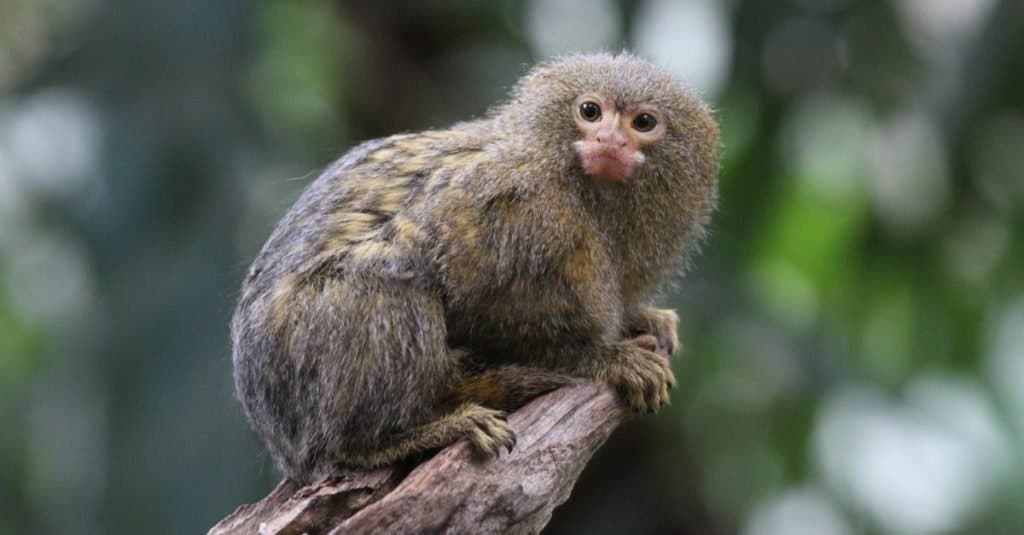
The pygmy marmoset is the smallest monkey on the planet and only weighs around 3.5 ounces.
©Mihai Ivascu/Shutterstock.com
At an average size of 5.1 inches and weight of 3.5 ounces, the pygmy marmoset is considered the smallest monkey in the world. Found in the Amazon basin, this tiny monkey is in its own genus, Cebuella. It lives in family groups made up of a male, a female, and their children, and maybe another adult. They use vocalizations, chemical secretions, and visual displays to communicate with each other. There are two species of this marmoset. They are the western and the eastern pygmy marmoset, and they are nearly identical.
The dense fur of this monkey is a mix of brown, gold, gray, orange-yellows, and blacks. The tail, which is longer than the body, is ringed. The monkey can swivel its head 180 degrees, leap as far as 16 feet, and has a digestive system made for breaking down tree sap and other exudations.
As with other marmosets, only one female breeds, and the entire family pitches in to care for the young.
As the top four smallest types of monkeys are all marmosets, one might imagine that their size would make them good candidates for an exotic indoor pet. Actually, they are not recommended as a good choice for several reasons. For one, they like to mark territory with scent, so would be unsuitable for indoor living. They are also very social creatures and thrive within their family group, so separating one out would not be in its best interests. And lastly, while intelligent creatures, they get easily bored and can be a handful.
Honorable Mentions: More Small Monkeys
While we’ve covered 10 of the smallest monkeys on Earth, there are a couple of others that didn’t make our list but are noteworthy for their small stature.
Tarsier

Tarsiers are small nocturnal monkeys, notable for their huge eyes.
©iStock.com/Rachel Palmer-Goncalves
Tarsiers are a monkey species native to the Philippines, Indonesia, Malaysia, and Brunei in Southeast Asia. Found in forests, they are characterized by their wide heads which showcase huge eyes, hands with long, bony fingers, and rounded bodies covered in brownish fur. They have an average weight of 80g – 165g (2.8oz – 5.8oz) and a height of 9cm -16cm (3.6in – 6.4in).
Emperor Tamarin
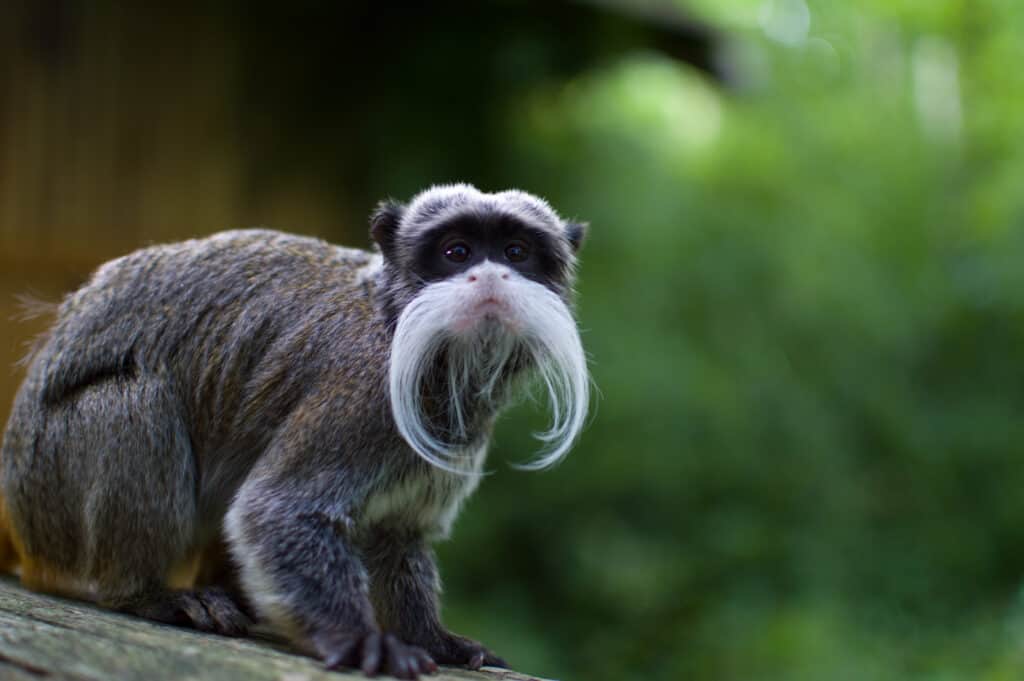
The Emperor Tamarin is a New World Monkey that is the size of a squirrel.
©iStock.com/Jharpy
Another species of tamarin monkey is the emperor tamarin, which lives in northern Brazil, the Amazon Basin, and in Peru and northern Bolivia. It’s named for the German emperor Wilhelm II because of its long white beard that curls downwards. Its length is 9-10 inches (23-26 cm), its tail is another 13-16 inches, and it weighs a mere 18 ounces.
Summary of the 10 Smallest Monkeys in the World in 2024
| Rank | Monkey | Size in Weight |
|---|---|---|
| 1 | Pygmy Marmoset | 3.5 ounces |
| 2 | Roosmalen’s Dwarf Marmoset | 5.29-6.52 ounces |
| 3 | Silvery Marmoset | 48 ounces or 3 pounds |
| 4 | Common Marmoset | 8.3-9 ounces |
| 5 | Graells’s Tamarin | 7.9-32 ounces |
| 6 | Cotton-Top Tamarin | Less than a pound |
| 7 | Night Monkey | 1-2.8 pounds |
| 8 | Squirrel Monkey | about 28.33 ounces |
| 9 | Dusky Titi | 18-39 ounces |
| 10 | Talapoin Monkey | 1.76-4.19 pounds |
Smallest Monkeys in the World vs. Biggest Monkeys
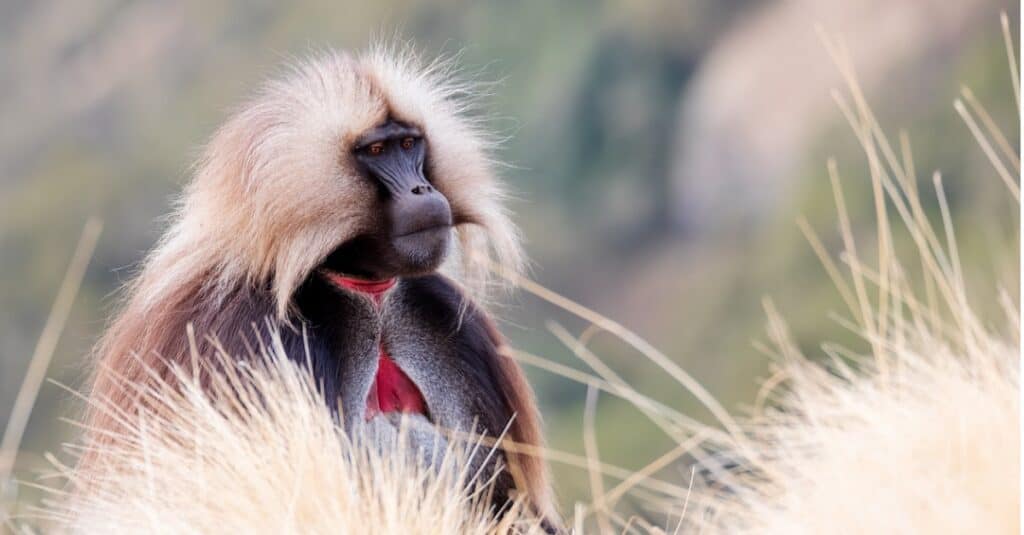
The distinctive looking Gelada monkey is one of the 10 largest monkeys in the world.
©Artush/Shutterstock.com
Has learning about the 10 smallest monkeys in the world made you wonder which monkeys are the biggest on our planet? Here’s a list of the 10 largest monkeys in the world, with more details and colorful photos in this article: The World’s 10 Largest Monkeys.
- Mandrill – 119 lbs
- Drill – 110 lbs
- Chacma Baboon – 99 lbs
- Olive Baboon – 82 lbs
- Hamadryas Baboon – 66 lbs
- Proboscis Monkey – 66 lbs
- Tibetan Macaque – 66 lbs
- Nepal Grey Langur – 58 lbs
- Yellow Baboon – 55 lbs
- Gelada – 45 lbs
The photo featured at the top of this post is © Peter Goffa/Shutterstock.com
Thank you for reading! Have some feedback for us? Contact the AZ Animals editorial team.




